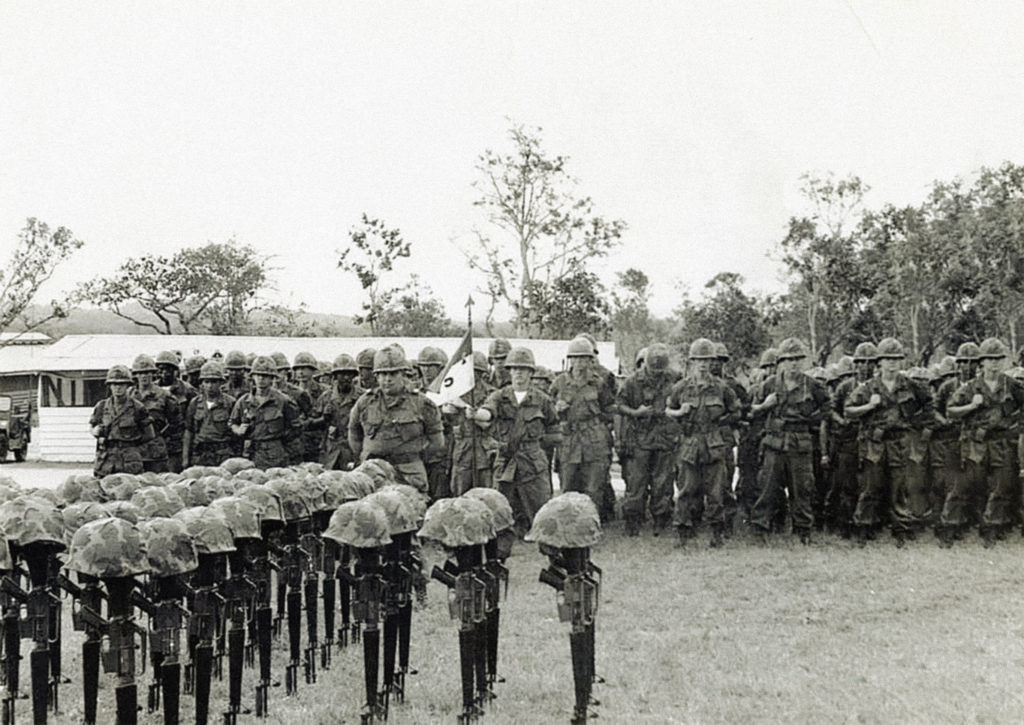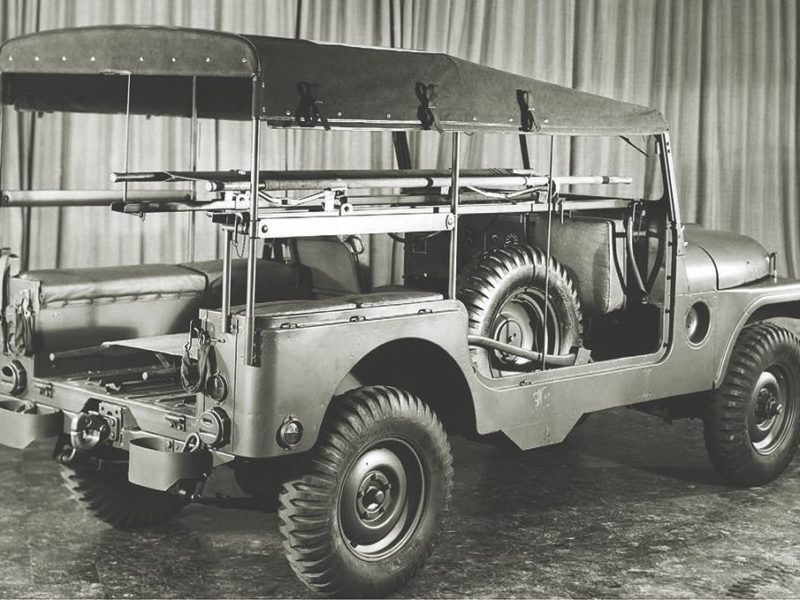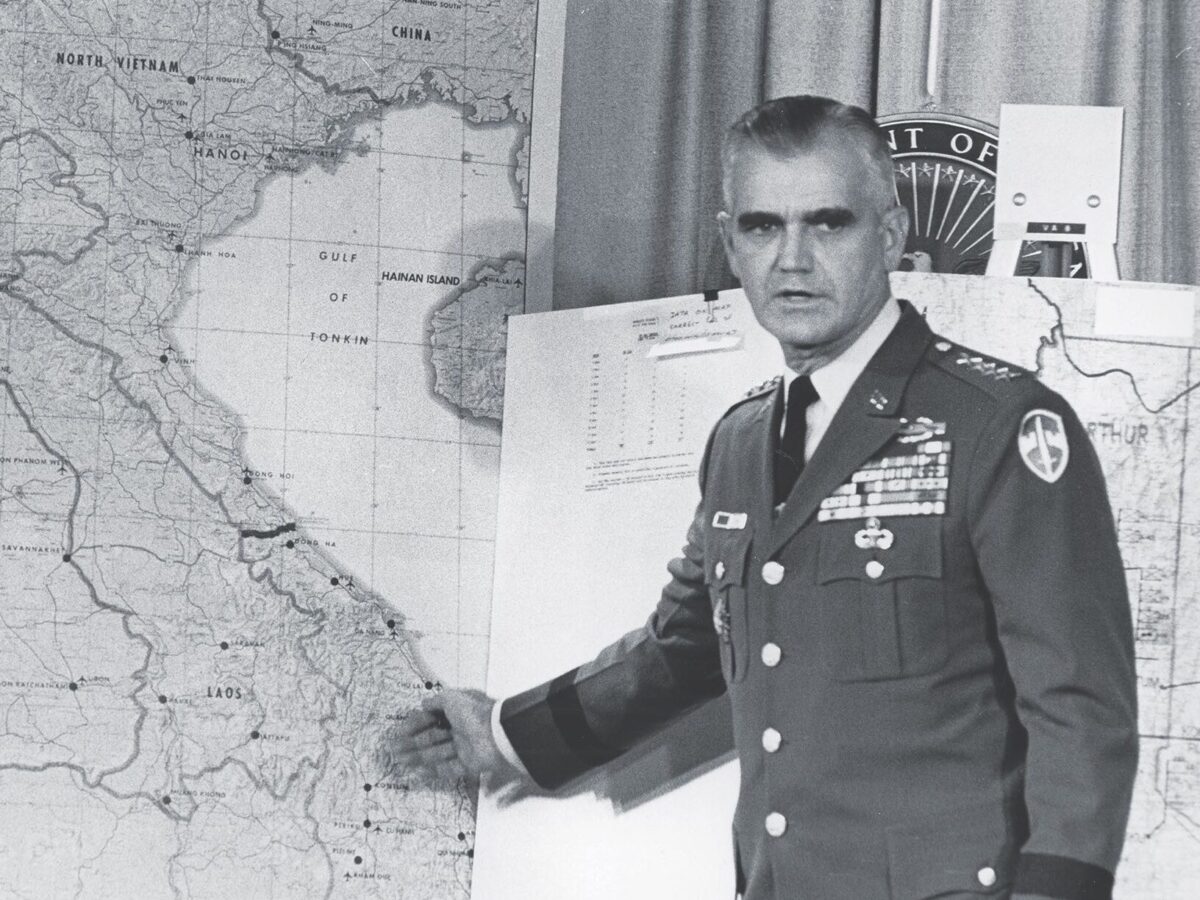Lieutenant Ed Knoll was awakened by his foot being gently pushed, the cautious and safe method of waking someone in combat. A handset was shoved in his face, and the radio telephone operator said, “EL TEE, urgent call from Defiant 3,” the battalion operations officer’s call sign. It was an operations alert for Knoll, a first lieutenant and commander of Alpha Company, 1st Battalion, 28th Infantry Regiment (the Black Lions), 1st Infantry Division. The call to Knoll, at the An Loc firebase about 95 kilometers north of Saigon, came just after midnight Sept. 12, 1968. The lieutenant’s unit was trucked to nearby Quan Loi, and in the morning the 1st Battalion (minus B Company handling base security at Quan Loi) was airlifted north to Loc Ninh.
Recommended for you
On Sept. 11, the North Vietnamese Army had attacked Loc Ninh, hitting local and regional militia groups as well troops from South Vietnam’s regular army. The town, a district capital surrounded by rubber plantations, was about 110 kilometers from Saigon on Highway 13, a major artery that ran south from Cambodia and provided a direct corridor into the Saigon area for advancing enemy forces.
On the day of the NVA attacks, the 1st Infantry Division’s 1st Brigade, headquartered at Quan Loi (20 kilometers southeast of Loc Ninh), sent several units to the Loc Ninh airstrip: 1st Battalion, 2nd Infantry Regiment; E Troop, 2nd Squadron, 11th Armored Cavalry Regiment; and Battery B, 1st Battalion, 5th Field Artillery Regiment (105 mm howitzers). Knoll’s Alpha Company and others in the 1st Battalion, 28th Infantry, commanded by Lt. Col. Leland Rew, arrived around 10 a.m. on Sept. 12. Additional artillery support—Battery D of the 1st Battalion, 5th Field Artillery—was flown in that evening. On Sept. 13 the 2nd Battalion, 16th Infantry Regiment, was deployed into blocking positions north of Loc Ninh.
An Ominous Mission
When Alpha Company was prepping earlier at Quan Loi, Pfc. Dave Himmer of Lima Platoon and Pfc. Bob Gruen of Mike Platoon saw some of the “old guys” taking “last” photos. When they asked why, the old guys said, “Loc Ninh is a badass area. Not all of us will be coming back.” Himmer and Gruen, who had been in Vietnam only a couple of months and not yet seen a sizable firefight, thought it was a scare tactic.
Four days later the two “newbies” would be considered seasoned “old guys.”
When the troops in Rew’s battalion had arrived at Loc Ninh on Sept. 12, they could hear that the 1st Battalion, 2nd Infantry, commanded by Lt. Col. Thomas Fitzpatrick, was already heavily engaged with an NVA force east of the airstrip. E Troop of the Armored Cavalry, with an element of Bravo Company from Fitzpatrick’s infantry battalion, had been deployed to blocking positions 5 kilometers north of Loc Ninh and engaged in light contact on the way to those positions.
Companies in Rew’s battalion started sweeps of the area: Delta to the west curling to the north and back to the airstrip, Charlie to the northeast and Alpha slightly east of Charlie.
The Reconnaissance Platoon was held at the airstrip. Each of the maneuver elements had only one gun of artillery. Fitzpatrick’s battalion was receiving all available artillery support for its fight. Delta made its sweep without any contact and returned to the airstrip to provide night security. This would not be the case for Alpha and Charlie companies.
At 2 p.m., a helicopter gunship was shot down southeast of Fitzpatrick’s men. The recon platoon from Rew’s battalion was flown to a landing zone near the downed chopper.As the platoon moved out from the LZ, it came under attack, suffered casualties and had difficulty returning to the landing site under the heavy fire. By 2:30 p.m., with artillery and gunship support, the recon platoon got back to the LZ and was lifted out with its casualties by 3 p.m.
Meanwhile, Alpha and Charlie made light contact with the enemy about 2:15 p.m., but by 3 p.m. both units were in heavy fighting, with Knoll’s Alpha Company in the more critical situation. E Troop, with the Bravo Company element, had been recalled from its position to assist in the relief of the recon platoon but was redirected to Alpha’s location in a rescue mission.
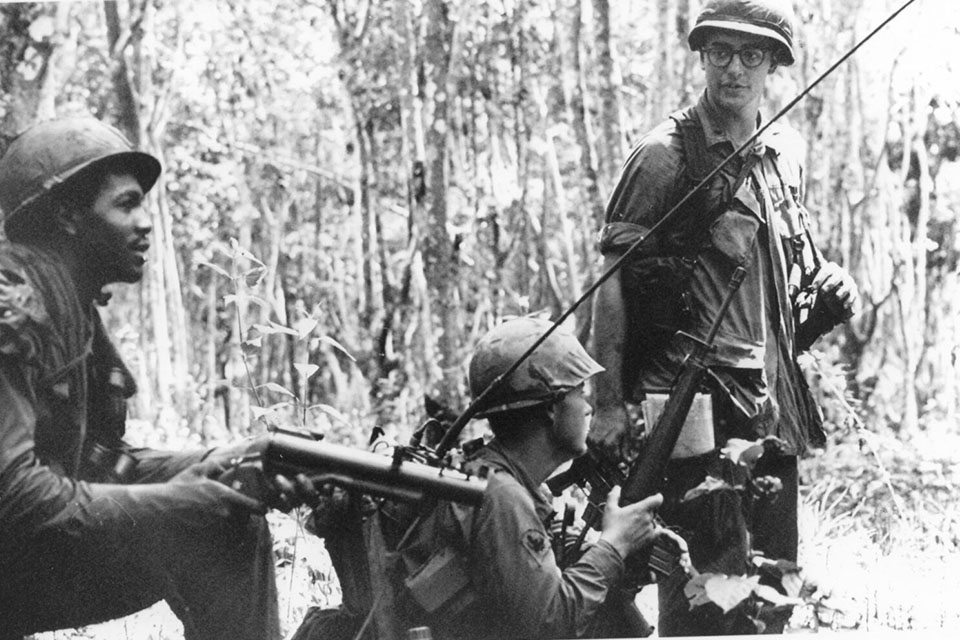
Alpha had moved slowly through the first two checkpoints on its route and saw no indication of the enemy. It had gone about 2 kilometers from Checkpoint 2 when an NVA soldier was spotted in a makeshift rubber workers’ hut. He was fired on and killed. Alpha then “cloverleafed” the area—with teams sweeping out in different directions and then circling back.
Finding nothing, the company continued for about 200 meters, saw three NVA troops and fired, killing two. Mike Platoon sent out a squad to do a cloverleaf. The squad had moved east about 150 meters when it came under automatic weapons and small-arms fire. The enemy then added rocket-propelled grenades and mortars to the barrage.
Mike Platoon’s leader reported at least eight killed and four wounded. He requested help to get the casualties out. Knoll, however, believed the enemy fire was too heavy for a retrieval effort—the casualties were “bait in the trap.” Therefore, he moved Lima and November platoons on line with a gap between them, laid down a base of fire and directed Mike Platoon’s leader to pull his unit back through the gap.
Knoll then took Alpha back 75 to 100 meters and established a 360-degree defensive perimeter. In front of the perimeter were placed Claymore mines, which shoot out hundreds of steel pellets after being detonated from a safe distance using an electric wire.
GET HISTORY’S GREATEST TALES—RIGHT IN YOUR INBOX
Subscribe to our HistoryNet Now! newsletter for the best of the past, delivered every Monday and Thursday.
Ambushed in a rubber plantation
“I contacted Defiant 3, informing him of our situation, the need for maximum artillery support and any other fire support available,” Knoll recalled. “While reporting, I could see 200 to 300 NVA working their way around us. The rubber plantation was crawling with NVA. In short order we were surrounded, outnumbered and outgunned with mortars and RPGs hitting the rubber trees.”
Alpha’s one 105 mm howitzer wasn’t enough in this situation. Two helicopter gunships—UH-1 Iroquois “Hueys”—flew in to help. But rain started coming down too hard for Alpha to mark its position for the copters with smoke grenades, and the Hueys returned to Loc Ninh.
Private Himmer of Lima Platoon was crawling back into Alpha Company’s perimeter after setting up his Claymore mines when a RPG whooshed over his head, exploding on a tree. Then the NVA fired at the Americans with everything it had—mortars, RPGs, small arms and automatic weapons.
“We had nearly walked into an ambush,” Himmer said. “Lieutenant Knoll’s directive to pull back and set up a perimeter saved Alpha. We were still in a fight for our lives. Over the din, I could hear LT calling for help on the radio, asking for whatever support we could get. As the NVA were moving toward and around us, it started to rain so hard we couldn’t see anything. It was hard to sight an M16 [rifle] or M60 [machine gun]. When it would let up a little we could see the NVA moving from tree to tree. They were all over. We just kept firing.”
Pfc. Lyle Leonard remembers the stream of NVA tracer bullets that left a glowing green trail that showed shooters where their rounds were hitting. Every fifth bullet was a tracer. “It seemed like solid green above us,” Leonard said.
“I didn’t want to raise my head and fire, but I had to, so I did it. It was all like a very bad dream.”
Every time Gruen hears “The Star Spangled Banner,” he remembers that night. “When the NVA would fire those RPGs, there would be a big red flash out in the rubber,” the Mike Platoon private said. “Then there would be an explosion in the trees above our heads. It was the rockets’ red glare and bombs bursting in air.’”
Pfc. Glenn Patton of Lima Platoon says the coolness under fire displayed by Knoll and Staff Sgt. Terry Richardson, his platoon leader, helped him focus on his duty, rather than thinking about the overwhelmingly bad situation Alpha Company appeared to be in.
Tracers EveryWhere
A Mike Platoon squad leader, Sgt. Bob Parker, pulled his men back from the enemy fire and into the company’s defensive position. “As we formed into a perimeter, I had my men use the base of rubber trees for cover as they fired,” Parker said. “Quickly everyone was covered with leaves. The air above us was green! Tracers were crisscrossing from every direction.”
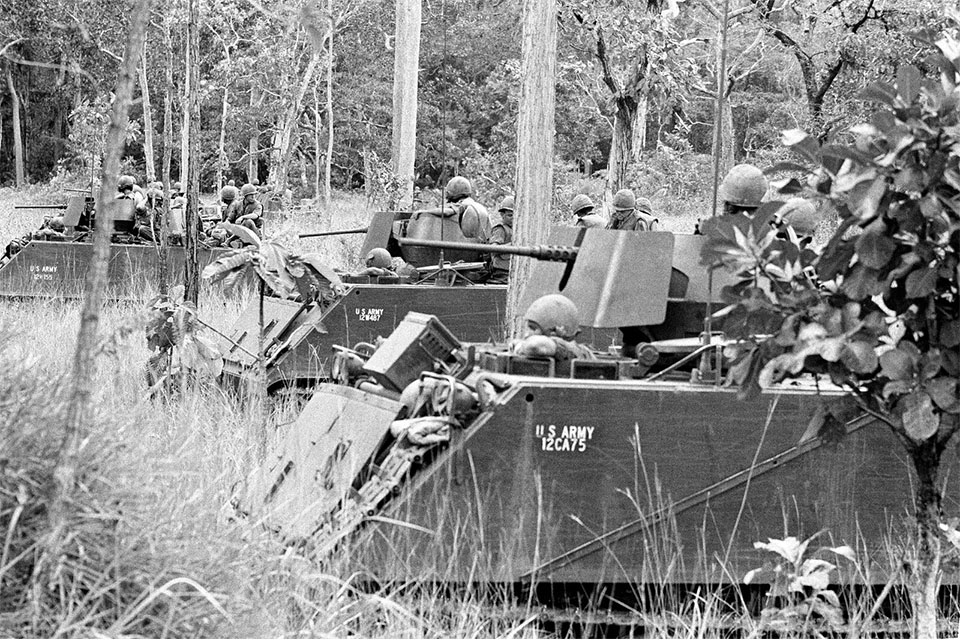
The battle—and the rain—intensified. The rain would pour down in hard squalls, let up some, then strengthen. The NVA firing didn’t let up at all. The enemy soldiers were creeping in and closed to within 25 meters. Alpha started detonating the Claymores, which eased the immediate pressure. Knoll was told that the cavalry was on its way.
“NVA were everywhere,” said Pfc. Pete Sasko, a Lima Platoon rifleman. “The rubber was crawling with them. Once it started to get dark, the flares lit them up making them look weird.”
The Cavalry Arrives
Sgt. Norm Meier, a squad leader in Lima Platoon, recalls that evening. “As we formed our perimeter one of my machine gunners was hit,” he said. “I took over the gun, firing so much that I was worried that I would either burn up the barrel or run out of ammo. I could see NVA running from tree to tree before it started raining. Once it got dark I could see them with every flare. I was praying as hard as I was firing, trying to keep from being overrun.”
“The cavalry arrived and came to our rescue! I got more ammo from them just as I was running out. My prayers were answered.”
The arriving soldiers from E Troop—mounted on M113A1 armored cavalry assault vehicles, or ACAVs—had fought their way through the NVA with the attached Bravo Company element and reinforced Alpha’s defensive perimeter by 5:45 p.m. Entering the perimeter, the cavalry commander saw more than 100 NVA troops advancing toward the Americans.
Once they were inside, the cavalry troops opened up with their .50-caliber and M60 machine guns, providing 360-degree coverage. The enemy firing intensified before momentarily slacking off. Then the RPGs started coming in. But the cavalrymen kept firing away.
Surrounded in the dark
Around 7 p.m., 1st Infantry Division commander Maj. Gen. Keith Ware contacted Knoll by radio. “He directed us to move out and link up with Charlie Company, about 2 kilometers north,” Knoll recalled. “I explained our present situation: surrounded by many NVA, in heavy contact, dark and raining.”
Mike Platoon’s cloverleaf squad casualties were about 200 meters from the perimeter, and some wounded were inside. Knoll told Ware that his men weren’t in a position to move.
“He insisted that the situation wasn’t as bad as I was reporting,” Knoll remembered. “He then radioed the E Troop commander, ordering him to move [to Charlie Company]. The cavalry commander agreed with my assessment. He wasn’t going to chance moving his ACAVs and dismounted troops at night, navigate around rubber trees with only the illumination of artillery flares, while trying to fight through the NVA encirclement. We stayed put. We had probes, mortars and RPGs most of the night.”
Clearing a Way
Later that night Alpha started knocking down rubber trees with explosives to make a landing zone for a medevac helicopter. The “dustoff” copter arrived around 1 a.m. The whole American perimeter fired rounds to suppress the enemy fire while the dustoff pilot was dropping into the hole made by the downed trees.
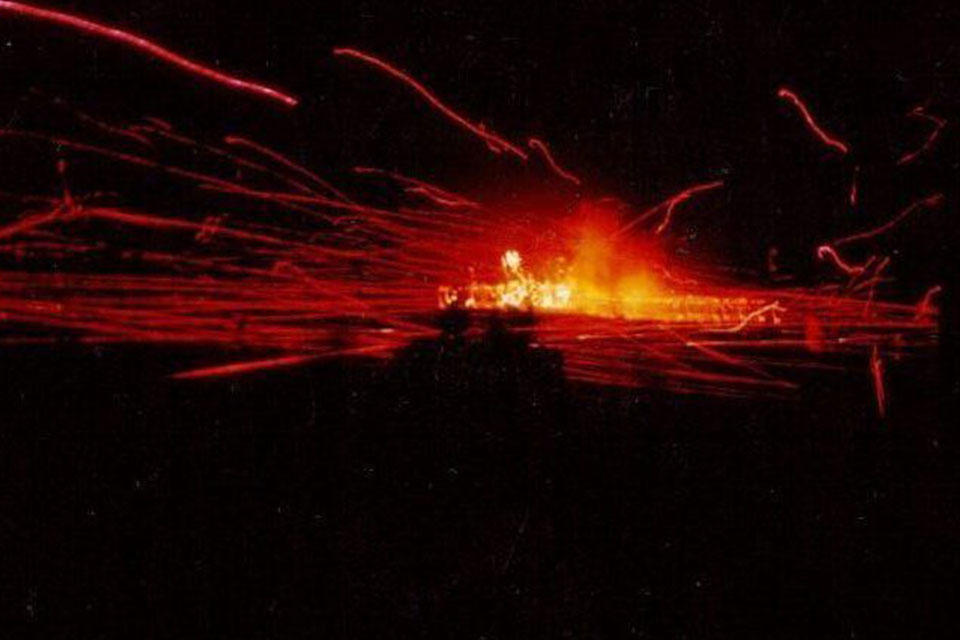
“It was inky dark except for ground flares and artillery flares giving off really weird light,” Private Leonard said. “The pilot moved the chopper back and forth, clipping leaves from branches, as he settled the chopper down. The crew was hanging out of the doors guiding him in.”
The dustoff brought in much needed ammunition, water and battalion commander Rew, who took charge of the force. After the wounded were loaded, the dustoff lifted straight up and out of the hole.
During the early portion of the battle, Air Force Maj. Ingram Ottinger, flying above Alpha in his L-19 Bird Dog observation plane, came on the radio. He had fast-moving fighters circling nearby and making runs to the battle site.
The perimeter on the ground was marked by an outside ring of green tracers from the incoming NVA fire and an inner circle of red tracers created by outgoing American bullets. Ottinger fired spotting rockets outside the red circle to mark targets for the jet pilots. For much of the night, he dropped flares and brought in air power to support the troops below.
When Ottinger finally departed, he said he would be back first thing in the morning, and Knoll offered him a bottle of Jack Daniels if he returned. The major was true to his word and stayed through the rest of the battle, leaving only briefly to refuel at the Loc Ninh airstrip. (When Alpha returned to Quan Loi after the battle, Ottinger flew in to get his Jack Daniels. “He earned that and more,” Knoll said. “He helped us survive the night.”)
‘Don’t lose Your head!’
At first light on Sept. 13, a Mike Platoon patrol, supported by two ACAVs, searched for the platoon’s cloverleaf unit. Private Gruen remembers a sergeant giving the squad instructions: “Everybody out there is dead. I don’t want anyone to get mad and lose your head. We’re going to pick them up and put them on the ACAVs. Rule No. 1, don’t go in front of the ACAVs. Rule No. 2, don’t lose your head!”
As the search patrol approached the area of the cloverleaf squad, “we could see bodies,” Gruen said. “We heard someone saying ‘help me!’ Kinser hollered, ‘Who is it?’ ‘Steadman’ was the reply. As soon as we heard Steadman, everyone, led by Sergeant Kinser, rushed ahead of the ACAVs. Bernie Steadman and Doug—can’t recall his last name, the machine gunner from Philly—were alive but badly wounded from gunshots and stab wounds. The rest of the bodies had been shot, stabbed and cut up. We were PO’d. As they were being loaded into the ACAVs, an NVA soldier came out from behind a tree. Washington Norfleet fired his M79 [grenade launcher] from the hip, hitting the NVA in the shoulder area. It was too close for the grenade to explode [the round needed approximately 15 meters to arm itself.] The NVA just slid down the tree. After seeing what was done to our guys, Sergeant Kinser finished him off with a full magazine burst. He was angry.”
After recovering the dead and wounded, the battalion moved to an open area, evacuated the casualties, got resupplied and moved to link up with Charlie Company, commanded by Capt. Michael Hageman, whose contact with the NVA had ceased late in the evening of Sept. 12.
Back at Quan Loi, Alpha clerk Spc. 4 Jerry Simecka had been hearing rumors that the company was overrun and wiped out. “It wasn’t until the morning of Sept. 13 that I was able to get an official report from the battalion XO [executive officer] who tasked me to ID Alpha’s KIAs at the Quan Loi graves registration point,” he said.
“It was the best day and the worst day of my life. The company hadn’t been wiped out, but I had to ID eight of my guys.”
After the linkup, Rew’s battalion and E Troop, with the Bravo infantry element, moved toward Hill 222 to do a sweep of the area. The units advanced in a box formation—Alpha on the left, Bravo on the right, and Charlie interspersed in the box.
At one point the Americans saw considerable movement in front of them. E Troop opened up with machine guns. Rew called in air support. As the planes did their work, E Troop was detached by the brigade operations staff to rescue Fitzpatrick’s battalion, in a pitched battle with a large NVA force east of Loc Ninh.
When the airstrikes ended, Rew’s battalion, without E Troop, moved toward Hill 222. The air above was crowded: Ottinger’s Bird Dog, gunships and their controller, at least one command-and-control ship, all circling the area. Charlie Company received heavy fire from dug-in bunkers and was pinned down. Alpha moved up and laid down fire to assist Charlie’s pullback.
Knoll again was on the radio with division commander Ware, in his command-and-control helicopter. “This time,” Knoll remembered, “I was instructed to ‘stop acting like a coward and fight as you have been trained.’ At that moment, we were trying to pull out of the hornet’s nest, with .51-caliber rounds snapping overhead and around us, shredding rubber trees. I could only respond with ‘Roger, out.’ We continued to pull Charlie’s casualties back.”
Shortly afterward, Rew was notified that Ware’s chopper had been shot down. All aboard were killed, seven men and the general’s dog, King.
Air support was called in for 12 to 14 strikes on Hill 222. Alpha moved forward to collect the rest of Charlie’s casualties, and then the battalion pulled back to set up a night defensive perimeter.
Another assault plan was formed for the next day, Sept. 14. Alpha was to lead, approaching from a more northern direction, skirting the hill. The assault was met by heavy machine gun, RPG and mortar fire. The lead squad from Lima was shot up. Even with an entire 105 mm battery firing, the shelling didn’t affect the NVA troops in their well-built bunkers.
As Alpha pulled back with the casualties, Lima Platoon’s Sergeant Richardson grabbed a radio, crawled through the outer bunker area and called in airstrikes, napalm, bombs and cannon fire—all aimed at the enemy base camp.
“I was in a small irrigation ditch hiding behind a rubber tree that was smoldering from napalm,” Richardson said. “When the strikes were over, I couldn’t believe how many NVA were still around. They were moving down the backside of the hill. I could see them, but couldn’t hear anything. My hearing had been messed up by the strikes. Then a sniper in a tree shot me in the leg.”
As the NVA broke contact late that afternoon, a squad from Lima Platoon moved forward to recover Richardson. As they approached the sergeant, Spc. 4 Robert Grier spotted a sniper chained to his perch in a rubber tree and shot him.
They found Richardson dazed and bleeding from the ears but alive with a leg wound. There were NVA bodies all around him.
The battalion stayed in the defensive position for the night, pushing onto Hill 222 the next morning. There was no resistance as the men slowly made their way through the massive complex of well-constructed and camouflaged bunkers. The NVA had withdrawn from the site, determined to be the 7th NVA Division’s base camp. The departing troops had removed their dead.
It was a costly battle: Alpha entered Loc Ninh with 102 soldiers and returned with 82—losing eight killed and 12 wounded. The 1st Brigade after-action report tallying the losses for all units recorded American casualties of 70 killed and 488 wounded and NVA losses that included 608 confirmed killed.
Jeff Harvey, a retired Army lieutenant colonel, was commanding officer of Alpha Company, 1st Battalion, 28th Infantry Regiment, 1st Infantry Division, from October 1967 to March 1968. This narrative was compiled from Alpha Company oral histories and the after-action report by the 17th Military History Detachment, 1st Infantry Division.
This article appeared in the June 2017 issue of Vietnam magazine.
historynet magazines
Our 9 best-selling history titles feature in-depth storytelling and iconic imagery to engage and inform on the people, the wars, and the events that shaped America and the world.



